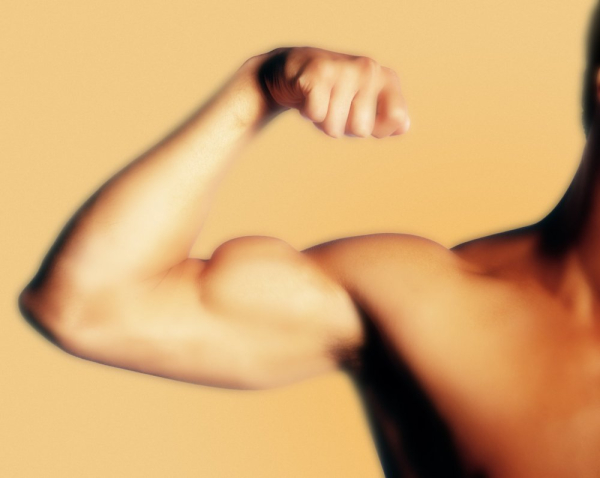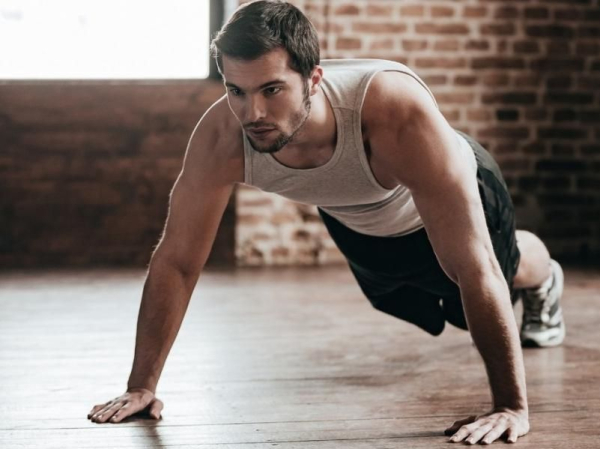
It's not just the eagle that has two heads, but also a muscle. In physically cultured societies, it's commonly called a biceps, and it commands no less respect than the heraldic bird.
The only problem is that, unlike an eagle, a bicep requires constant attention and maintenance to keep it in shape worthy of respect. We'll tell you how to do this properly.
Preliminary information
Developed biceps have always been a symbol of strength. Stop anyone on the street and ask them to show you their muscle. Unless they're a maniac, they'll show you a flexed bicep. A beginner entering the gym for the first time typically begins their workouts with these muscles. However, the most effective way to build perfect biceps involves avoiding focused arm work. A much better approach is to use compound exercises for the chest and latissimus dorsi—pull-ups, for example. Therefore, biceps training is often combined with back training. If you work these muscles separately, you'll need at least 48 hours between workouts to allow for full muscle recovery and growth.
Dividends
Image
Biceps are one of the few muscle groups that are almost always visible. Well-developed arms can convince others that the rest of your body is just as perfect.
Broad back
Back exercises require the biceps to work. Therefore, the stronger your arms, the more weight you can use in back exercises.
Strong grip
Almost all biceps exercises strengthen the tendons and muscles of the forearms and hands. A firm, manly handshake is guaranteed.
Ideal running technique
Keeping your arms bent while running, especially over long distances, helps you maintain a perfect rhythm. Strong biceps will improve your endurance, allowing you to better control your arm movements while running.
The best sex
Certain positions, such as any of the standing variations, require considerable arm strength. Well-developed biceps will help you hold her legs or her entire body up for as long as necessary.
Main movement
Nothing adds volume and definition to your biceps like barbell curls. With them, you can use more weight than any other exercise.
Execution
Grasp the bar with an overhand grip (palms facing up) at shoulder width. Your elbows should be pointed straight down, and the bar should be positioned directly in front of your hips. Keeping your back straight, engage your abdominal muscles, and as you exhale, lift the bar in a circular motion until your forearms touch your upper arms.
Subtleties
Wheel alignment
By moving your hands slightly closer together, you'll shift the work to the outer portions of your biceps; by moving your hands slightly wider than shoulder-width apart, you'll focus on the inner portions of your biceps.
Do it in order
First your wrists, then your forearms. Before lifting the bar, bend your wrists down slightly—this will take some of the load off your forearms and transfer it to your biceps.
Use a towel
You can strengthen your grip by doing bicep curls with a towel wrapped around the bar.
Bend your knees
Reduce the weight by about 20 percent and try doing this exercise in a kneeling position.
pose. Now it will be much more difficult for you to slack off by using your back to help you lift the weight. This way, you'll be better able to focus on working your biceps.
Class schedule
Building biceps is easier than you think. Unlike other muscle groups, which require work from different angles, curls are always curls—no matter what you do. Of course, this doesn't preclude a creative approach to training. By varying your exercises, you'll prevent your biceps from becoming tired from monotonous work and stimulate their growth. Follow our advice: after performing barbell curls, choose one exercise from Section A (biceps) and one from Section B (biceps/brachialis/forearm). Then, using the chart as a guide, build your own routine. Either way, our training plan will give you arms worthy of an Atlas.
A
Concentration curls
Sit on the edge of a bench, rest your left hand on your knee, and hold a dumbbell in your right hand, keeping your elbow pressed against the inside of your right thigh. As you exhale, bend your arm holding the dumbbell, bringing it toward your shoulder. Pause, then smoothly return to the starting position.
Note: Before curling the dumbbell, rotate your thumb inward toward your left leg. Raising the dumbbell from this position will engage your brachialis more, adding extra muscle volume.
Scott Bench Barbell Curls (Priest Curls)
Sit on a Scott bench and hold a pair of dumbbells or an EZ-bar. Rest your shoulders on the incline bench and, keeping your back straight, bend your elbows until you feel a limp, keeping your elbows on the bench. Hold for a moment and return to the starting position.
Note: Instead of using free weights, move a Scott bench up to the lower pulley. By overcoming the resistance of the pulley, you'll achieve a more complete contraction of the biceps, which means you'll work more muscle fibers.
Standing dumbbell bicep curls
Stand up straight with dumbbells at your sides, palms facing up and forward. As you exhale, gently bend your arms, hold for a second, and then slowly return to the starting position.
Note: Try turning your palms toward you at the start of the movement. As you rise, rotate your arms outward so that at the culmination of the movement, your palms are facing each other. This will engage your forearms and brachialis muscles more and strengthen your wrists.
IN
Standing hammer curl
Stand up straight, holding a dumbbell in each hand, palms facing each other. Keep your back straight. Bend your arms, keeping your hands from rotating—your thumbs should always point up. Gently return to the starting position.
Note: Instead of holding the dumbbell by the middle of the handle, try holding it by the top of the handle. This will allow your forearms to rest and prevent them from engaging before your biceps tire.
Reverse Grip Barbell Bicep Curl
Stand up straight, holding a barbell with an overhand grip at shoulder width. As you exhale, bend your arms, lifting the barbell to shoulder level. Smoothly return to the starting position.
Note: Try doing the same with dumbbells; it will immediately become more challenging to maintain proper form. This will also further strengthen your forearms.
Dumbbell wrist extensions
Sit on the edge of a bench and hold dumbbells in your hands, shoulder-width apart. Place your feet shoulder-width apart. Place your forearms on your legs and extend your wrists upward as high as possible. Pause for a split second, then return to the starting position.
Note: By placing your palms up, you will be able to work the lower part of your forearms (wrist flexors) for full muscle development.
Alternative exercises
Bicep curls on the block
Attach a short, straight handle to a low pulley and stand one step away from it. Thanks to the short handle and the resistance created by the cable (it's angled), this exercise targets the muscle fibers in a slightly different way.
One-arm bicep curls (behind the back)
Stand with your back to the pulley and grasp the handle of the lower pulley in one hand. Take a couple of steps forward so that your arm is bent at a 45° angle to the floor. Bend your arm, bringing your working hand toward your chest, then smoothly return to the starting position. This will work your biceps in a new way.
Incline Dumbbell Curls
Sit on an incline bench (at an angle of approximately 45°), holding dumbbells in each hand. Keeping your elbows in place, bend your arms as you exhale. Gently return to the starting position. Incline curls allow you to start from a stretched biceps position.
EZ-Bar Bicep Curls
The curved bar takes the strain off your wrists. The EZ bar allows you to vary your grip width, and its short length makes it easier to maintain balance during the exercise.






